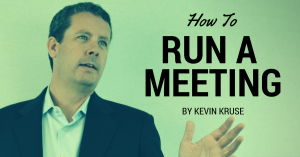

This article was originally published on Forbes.
Been to a great meeting lately? Yeah, didn’t think so.
Imagine if you could be known for running meetings that actually lead to great outcomes. Imagine if people actually looked forward to your meetings—and it wasn’t because you offered free food.
Most meetings are poorly organized, poorly facilitated, and highly inefficient. In fact, many of the 239 ultra-productive entrepreneurs I interviewed recently gave advice related to shortening meetings or avoiding them entirely. Billionaire entrepreneur Mark Cuban told me bluntly, “Never do meetings unless someone is writing a check.”
I identified four tactics that came up repeatedly in my research on how to run a meeting effectively.
1. Design An Effective Agenda
Successful people know that effective meetings begin with effective agendas, which are circulated in advance. Secrets to creating effective agendas include:
- Seek input on the agenda from participants before the meeting, so new topics don’t crop up and derail the primary goal.
- Clearly state the purpose of the meeting.
- Clearly state who the facilitator is.
- Identify all invited participants. The fewer the better, but you also want to make sure a key person isn’t being forgotten.
- List agenda topics as questions whenever possible in order to focus the participants on decision-making.
- Attach time estimates to each agenda item so participants can monitor the progress and pace of the meeting; make sure time estimates are realistic.
2. Ban Smartphones
In a previous article I wrote about why so many people—especially more successful people—find smartphone use in meetings to be inappropriate. It’s because when you access your phone, it shows:
- Lack of respect. You consider the information on your phone to be more important than the conversation in the meeting; you view people outside of the meeting to be more important than those sitting in front of you.
- Lack of attention. You are unable to stay focused on more than one item at a time; the ability to multitask is a myth.
- Lack of listening. You aren’t demonstrating the attention and focus that is required of truly active listening.
- Lack of power. You are like a modern day Pavlovian dog who responds to the beck and call of others through the buzz of your phone.
To make the most of valuable time spent in meetings, participants should mute and pocket their devices.
3. Use A Countdown Clock
Effective meeting facilitators make sure everyone is mindful of the time and that the meeting does not run long. Marissa Mayer was known for projecting a digital clock on the screen in her meetings.
Jake Knapp, design partner at Google Ventures, is an advocate for using a physical clock—called the Time Timer—to count down the time remaining in a meeting. Teachers have been known to call it “The Magic Clock.” Coming in various sizes—for about $25 from Amazon.com—the Time Timer is battery powered and large enough to be seen by meeting participants from across a room. A red disc silently spins, showing the amount of time remaining. Why not just set a timer on your smartphone? As Knapp wrote in a blog post:
“The Time Timer is WAY better than a timer app on a screen. Because it’s physical, it’s easier to adjust and set, and absolutely impossible to ignore.”
4. Don’t Sit Down
Haven’t you heard that sitting is the new smoking? Not only is sitting too long hazardous to our health, it leads to longer meetings. A team of psychologists in 1999 conducted research on the difference between sit-down and stand-up meetings across 56 different groups. As reported in the Journal of Applied Psychology:
“Sit-down meetings were 34 percent longer than stand-up meetings, but they produced no better decisions than stand-up meetings.”
Steve Jobs, Mark Zuckerberg, Richard Branson and Jack Dorsey are all well known for their long walking meetings. Branson wrote on his blog:
“One of my favourite tricks is to conduct most of my meetings standing up. I find it to be a much quicker way of getting down to business, making a decision and sealing the deal. When given the opportunity I often like to take things a step further – literally, with a walking meeting.”
The success of any organization is tied partly to the success of its internal communication. While a complete ban on meetings makes is perhaps a nice daydream, it’s not realistic and well run meetings are effective ways to make decisions, solve problems, and build social bonds. You can guarantee the success of your meetings by being clear in advance what the goal and topics are, eliminating distractions, ending on time and keeping people physically engaged.
========





